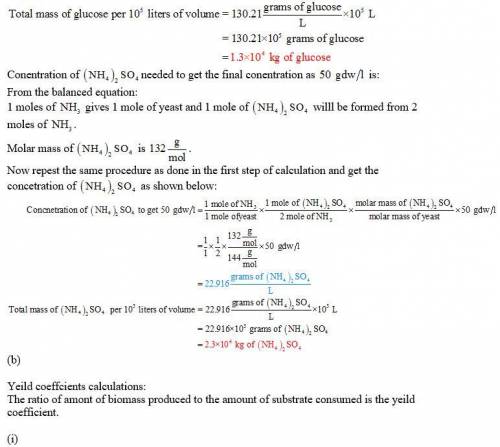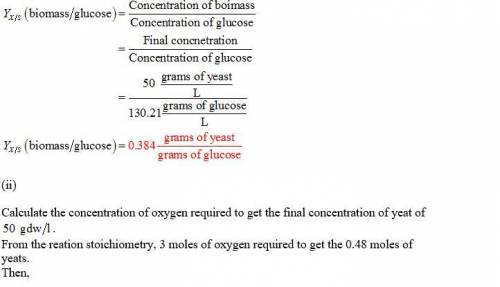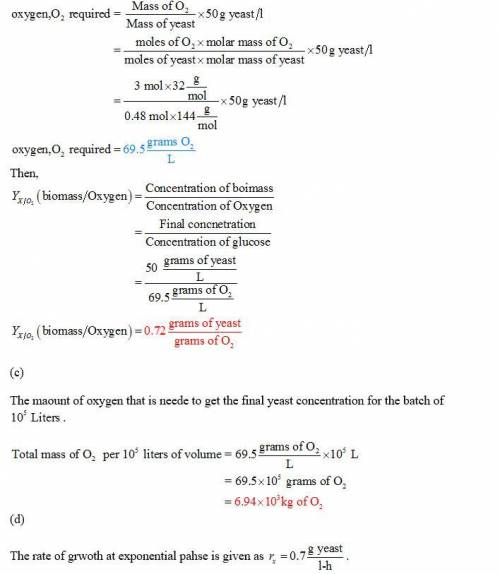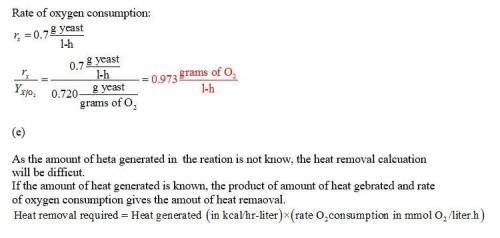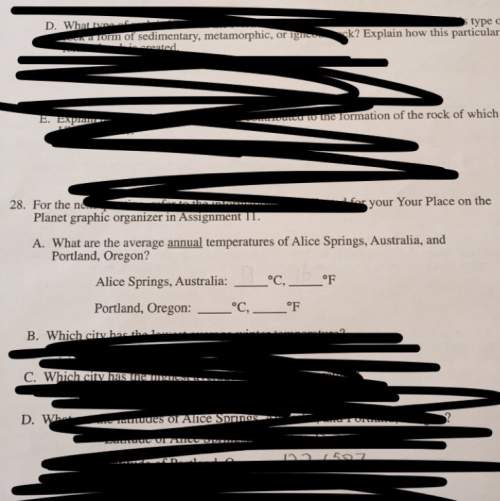
He growth of baker's yeast (S. cerevisiae) on glucose may be simply described by following equation CH,,06 3 02 0.48 NH,-> 0.48 C6H,,No, 4.32 H, O 3.12 CO2 yeast In a batch reactor of volume 10 1, the final desired yeast concentration is 50 gdw/1. a. Determine the concentration and total amount of glucose and (NH4),SO4 in the nutrient medium. b. Determine the yield coefficients YxIs (biomass/glucose) and Yro (biomass/oxygen). c. Determine the total amount of oxygen required. d. If the rate of growth at exponential phase is r, 0.7 gdw/l-h, determine the rate of oxygen consumption (g O,/1-h) e. Calculate the heat-removal requirements for the reactor (recall equation 6.26).

Answers: 1


Another question on Chemistry

Chemistry, 21.06.2019 23:00
What is the maximum amount of al2(so4)3 which could be formed from 15.84 g of al and 12.89 g of cuso4?
Answers: 2

Chemistry, 22.06.2019 08:30
In a chemical reaction at equilibrium, the rate of the forward reaction the rate of the reverse reaction. if the rate of the forward reaction more products are formed.
Answers: 1

Chemistry, 22.06.2019 11:20
Sodium nitrite (nano2) reacted with 2−iodooctane to give a mixture of two constitutionally isomeric compounds of molecular formula c8h17no2 in a combined yield of 88%. draw reasonable structures for these two isomers. click the "draw structure" button to launch the drawing utility. place the two compounds in the appropriate boxes below.
Answers: 1

Chemistry, 22.06.2019 14:30
What is the relationship between wind and ocean waves? question 17 options: wind moving at higher speeds will transfer more energy to the water, resulting in stronger waves. wind moving at higher speeds will transfer energy over a larger part of the ocean water, resulting in waves with a shorter wavelength. winds moving at higher speeds with cause water to move forward at faster rates, causing larger ocean waves. winds moving at higher speeds will affect deeper water, resulting in waves that move at a faster rate. how do temperature and salinity affect deepwater currents? question 15 options: as temperatures and salinity levels of water increase, the water rises to the surface where it creates currents as it moves to colder regions. they create changes in wind direction, moving denser water in the same direction as the wind and causing the deepwater circulation patterns found in the ocean. they equalize the forces on undersea currents caused by the coriolis effect as they replace more dense water with less dense water. they create density differences that cause dense deepwater currents to flow toward the equator where they displace less dense, warmer water above them.
Answers: 2
You know the right answer?
He growth of baker's yeast (S. cerevisiae) on glucose may be simply described by following equation...
Questions

English, 14.12.2020 20:40

Mathematics, 14.12.2020 20:40

Mathematics, 14.12.2020 20:40

Mathematics, 14.12.2020 20:40

Mathematics, 14.12.2020 20:40

Physics, 14.12.2020 20:40

Mathematics, 14.12.2020 20:40


Health, 14.12.2020 20:40

Mathematics, 14.12.2020 20:40








English, 14.12.2020 20:40

Mathematics, 14.12.2020 20:40

History, 14.12.2020 20:40


